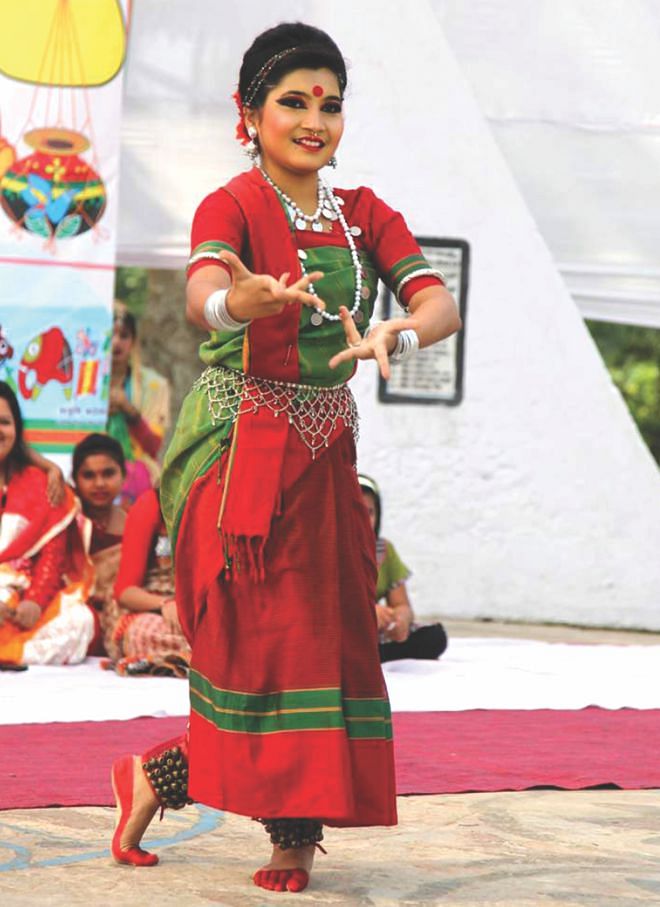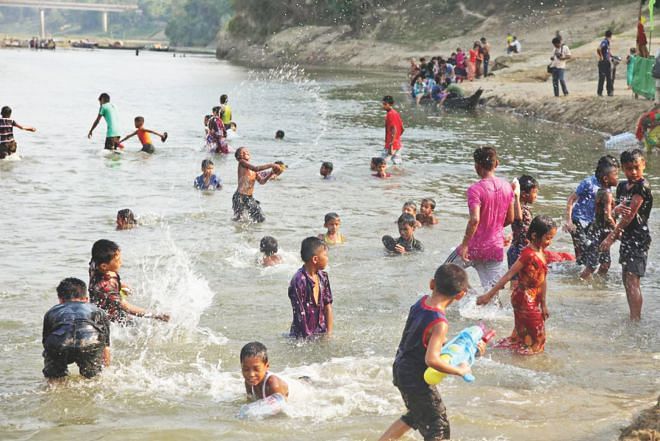Shades of Boisabi
Shades of Boisabi
Harmony, colour and verve in the hills

Boishakh is perhaps the sole festival that comes in every Bangalee's life living across the globe, with a call for linking the past with the present and welcoming the New Year with rapturous rhythms of rejuvenation, vibrant colours and new hopes.
Traditionally, Pahela Boishakh reminds us of ektara, dhak-dhol and shankhadhwani; the taste of panta-ilish and the daylong funfair in traditional attire.
Baishakh is celebrated with a difference in the hilly districts of Chittagong, though the theme of a fresh beginning is similar in every corner of Bangladesh. Here in the tranquil green hills, Boisabi -- as it is known -- is way different from Chhayanaut's Borshoboron and Charukola's Mongol Shobhajatra.
In CHT, the cultural co-existence and harmony in diversity is unique at Boisabi. Three predominant indigenous communities -- Chakma, Marma and Tripura -- celebrate the New Year in different ways and with different celebrations. The term 'Boisabi' originates from Tripura's festival 'Boisuk', the Marma's 'Sangrain' and the Chakma's 'Biju'.
Boisabi features time-honoured religious-cultural rituals: cultural events, children's painting competitions and traditional sports like Bolikhela (wrestling) and colourful processions. People of all ages, attired in traditional indigenous dresses, delve into celebrations adding different shades to the occasion.
The Chakmas set off the three-day Biju Utsab with 'Phool Biju', where young girls float flowers in water-bodies on the penultimate morning of the outgoing year, seeking divine blessings. On the last day of the year, called “Mul Biju,” they prepare a vast range of delicacies and offer these to the villagers. Their mixed vegetable curry -- called 'Pachan', and traditional pithas, served with 'Chuani' (locally brewed liquor) add to the celebrations.
The first day of the New Year called 'Gojjya Pojjya Din” is the day to start anew and pray to Lord Buddha for yearlong peace and prosperity. The Chakmas throw their homes open to guests, irrespective of community.
Meanwhile, a number of socio-cultural organisations held celebrations across the hill districts. Rangamati district administration arranged a cultural programme on April 14 to welcome Pahela Boishakh at Shaheed Minar premises where Bangalees living in the town gathered with colourful processions.

The Marmas celebrate their Sangrain festival, welcoming New Year. In the run up to the celebrations, they clean and decorate their houses, prepare traditional food and participate in rituals. Their biggest event is the water festival. People, mostly young boys and girls participate in the festival splashing water on each other. The Marmas, along with tourists and Bangalees gather at different points to take part in Sangrain.
They go to the pagoda, bathe Lord Buddha's statues in sandalwood-water and renew their commitment to Panchasheel (five precepts) and Ashtasheen (eight precepts). At the pagodas, monks remind them of the dharma -- the right path to living.
The Marmas render Sangrain songs while making their way peacefully to the predestined place for Punyosnan (holy bath). Everyone in the procession sings Marma songs in unison.
The Marmas in Bandarban brought out a colourful procession from Puratan Rajar Math on their way to the banks of River Shankha, where they performed religious rituals that included Buddha's holy baths.
Apart from the celebrations by Chakmas and Marmas, other indigenous groups in the CHT including Tripura, Tangchangya, Bom, Mro, Khumi, Khiyang and Chak celebrated the festival in their traditional way.
It is Boishakh that brings fresh hope, new possibilities and a renewed call to move on. And in the hilly districts, Boisabi is a festival that brings everyone together, celebrating harmony in heterogeneity.